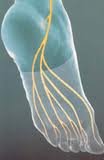The causes and treatment of Peripheral Neuropathy
If you have been suffering from constant or intermittent pain or have felt tingling or numbness in your extremities that just won’t go away no matter how much ibuprofen you take, you may be suffering from peripheral neuropathy. An estimated three to eight percent of the population suffers from this disease, a condition in which the signals traveling between the body and the central nervous system (the brain and spinal cord) are interrupted, causing sensations ranging from pain to burning, tingling, and numbness, and can also involve weakness and wasting of the muscles. It is particularly prevalent among those who have diabetes and becomes more common as we age.
 Although nerve damage can be tricky to treat, some forms of the condition are easier to treat than others. Peripheral neuropathy caused by diseases such as multiple sclerosis, lupus, AIDS, and cancer is the most difficult. However, a significant percentage of cases are due to more easily treatable causes such as vitamin deficiencies and compressed or trapped nerves. All of the above can be helped to a lesser or greater extent by applying a variety of treatment options; among the most useful of these are an improvement in diet and receiving regular chiropractic care.
Although nerve damage can be tricky to treat, some forms of the condition are easier to treat than others. Peripheral neuropathy caused by diseases such as multiple sclerosis, lupus, AIDS, and cancer is the most difficult. However, a significant percentage of cases are due to more easily treatable causes such as vitamin deficiencies and compressed or trapped nerves. All of the above can be helped to a lesser or greater extent by applying a variety of treatment options; among the most useful of these are an improvement in diet and receiving regular chiropractic care.
Getting oxygen and nutrients to damaged nerves is key in treating peripheral neuropathy, which is why eating plenty of fruits and vegetables rich in vitamins and antioxidants is important. These will feed the nerves and help to destroy the free radicals that cause damage to the body cells, leading to interference with nerve transmission.
Neuropathy of the arms and legs is the second most common ailment treated by chiropractors, according to the National Board of Chiropractic Examiners. When the vertebral joints of the spine begin to degenerate (which is common as we get older) it can press on the roots of the spinal nerves, causing the classic symptoms of neuropathy. Chiropractors are trained to relieve this pressure, performing spinal adjustments to bring the vertebrae back into alignment, releasing trapped or compressed nerves. Some chiropractors also use the fascial release technique or Active ReleaseTechnique (ART) to help release nerves that may have become impinged by the fascia (connective tissue).
According to a study published in the British Medical Journal in 2004, chiropractic adjustments, with or without exercise, improved symptoms more than medical care did after both 3 and12 months. And in 2008, the Journal of Chiropractic Medicine reported that patients showed an 85.5% resolution of the nerve symptoms after only 9 chiropractic treatments.
Chiropractic is a safe, gentle, and drug-free treatment that is effective in dealing with many cases of peripheral neuropathy. Your chiropractor can evaluate your particular situation and recommend a course of treatment that is right for you.
Other than chiropractic manipulation, acupuncture, cold laser therapy, and Graston treatment may be the good options of treating peripheral neuropathy.
For more information, call us at 303-750-3000.
Hope this helps. Thanks for reading!
Disclaimer: These statements have not been evaluated by the Food and Drug Administration. The products mentioned on this page are not intended to diagnose, treat, cure, or prevent any disease. The content in this blog should not be used as a substitute for the professional advice and/or recommendation of qualified healthcare practitioners or licensed physicians. The content presented in this blog is intended for information purposes only. Consult your doctor or healthcare practitioners for your current conditions.
ChiroPlus Wellness Care, LLC
303-750-3000
10700 E. Bethany Dr #207, Aurora, CO 80014